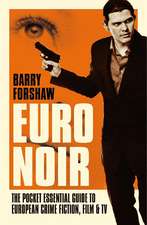The Critique Handbook: The Art Student's Sourcebook and Survival Guide
Autor Kendall Buster, Paula Crawforden Limba Engleză Paperback – 30 noi 2009
Preț: 480.13 lei
Nou
Puncte Express: 720
Preț estimativ în valută:
91.87€ • 96.18$ • 76.02£
91.87€ • 96.18$ • 76.02£
Carte disponibilă
Livrare economică 15-29 martie
Preluare comenzi: 021 569.72.76
Specificații
ISBN-13: 9780205708116
ISBN-10: 0205708110
Pagini: 145
Dimensiuni: 140 x 213 x 10 mm
Greutate: 0.18 kg
Ediția:2Nouă
Editura: Prentice Hall
Locul publicării:Upper Saddle River, United States
ISBN-10: 0205708110
Pagini: 145
Dimensiuni: 140 x 213 x 10 mm
Greutate: 0.18 kg
Ediția:2Nouă
Editura: Prentice Hall
Locul publicării:Upper Saddle River, United States
Descriere
This unique textbook is an invaluable tool for students in any art course requiring critiques. The Critique Handbook is an excellent resource both for beginners and more experienced students.
This text was written to address an existing gap in text offerings for art students. Although the critique is central to all art programs, there have been no textbooks or comprehensive guides to help students navigate the critique process. The Critique Handbook fills the need for such a book.
This text was written to address an existing gap in text offerings for art students. Although the critique is central to all art programs, there have been no textbooks or comprehensive guides to help students navigate the critique process. The Critique Handbook fills the need for such a book.
Cuprins
Preface
Section I: Framing the Discussion
Chapter One: Formal Matters
Chapter Two: The Story It Tells
Chapter Three: Making and Taking
Chapter Four: The Work in the World
Section II: Having the Discussion
Chapter Five: Critique Dynamics
Chapter Six: Critique Preparation and Exercises
Section I: Framing the Discussion
Chapter One: Formal Matters
Chapter Two: The Story It Tells
Chapter Three: Making and Taking
Chapter Four: The Work in the World
Section II: Having the Discussion
Chapter Five: Critique Dynamics
Chapter Six: Critique Preparation and Exercises
Caracteristici
Do you need The Critique Handbook for your studio courses?
- An excellent introduction to critique. Covering such fundamentals as how to prepare for a critique, how to look at work formally, and basic terms used in critique, this text is ideal to be assigned to all incoming students in any art department.
- Introduces students to the language and dynamics of critique.
- Helps them prepare for and get the most out of critiques.
- A lifelong reference. This handbook is also ideal for students who are more advanced in studio practice, as it will enhance their ability to clearly evaluate their own work and process.
- Serves as both sourcebook and supplement to critiques in the more advanced student's course of study.
- Universally applicable. The Critique Handbook can be used across the visual arts curriculum
- Provides an extremely useful conceptual framework, along with practical advice, for anyone who makes and evaluates art.
- An intuitive organization. This text is organized into two main sections:
- Section One, Framing the Discussion, consists of four chapters, which present ways to think about and discuss studio work. Ideas are presented on their own terms and through the imagining or reconstruction of critique situations.
- Section Two, Having the Discussion, examines the critique itself as a complex and dynamic discourse. It offers the student concrete advice on preparing for, engaging in, and getting the most out of critiques.
- Concrete examples from real critiques illustrate the points made in the text. These small narratives or dialogues are provided within the main text, and help students digest the material presented.
- Student-friendly. Written with the assumption that the reader may be new to the visual art critique, this text is readable and engaging.
- Interests students in the material.
- Important issues that arise in contemporary art discussions addressed. These include questions of authorship, site-specificity, and critical approaches for discussing new genres.
Caracteristici noi
- A completely rethought and revised fifth chapter on Critique Dynamics. Chapter five on what to expect from a critique has been completely overhauled to better prepare students to give and receive critiques.
- New sections, such as ‘Moderated Critiques,’ discuss the ins and outs of a less instructor-driven critique discussion.
- A rewritten opening section on ‘Who is Critiquing You?’ and an improved tone throughout the chapter make the text both more applicable and enjoyable for students and instructors alike.
- New material on Appropriation. The Critique Handbook helps you get your students start thinking and talking about ready-mades, the difference between high- and low-profile materials, and other advanced topics with new sections on:
- ‘The Question of Originality’
- ‘The Ethics of Appropriation’
- ‘Appropriation and Plagiarism’
- A revised and updated organization. By re-evaluating where information was placed in the text, the authors have created a simpler, more intuitive layout of material to help your students find the answers to their questions in the first place they look.
- By relocating material on Gender, Culture, Objectification and Language together into chapter four the flow of information has been significantly improved.
- Fusing sections, such as ‘Absolute Scale’ and ‘Relative Scale’ into ‘Scale’ helps students find what they’re looking for quickly and easily, all in one location.
Textul de pe ultima copertă
This unique textbook is an invaluable tool for students in any art course requiring critiques. "The Critique Handbook is an excellent resource both for beginners and more experienced students." This text was written to address an existing gap in text offerings for art students. Although the critique is central to all art programs, there have been no textbooks or comprehensive guides to help students navigate the critique process. "The Critique Handbook" fills the need for such a book.












